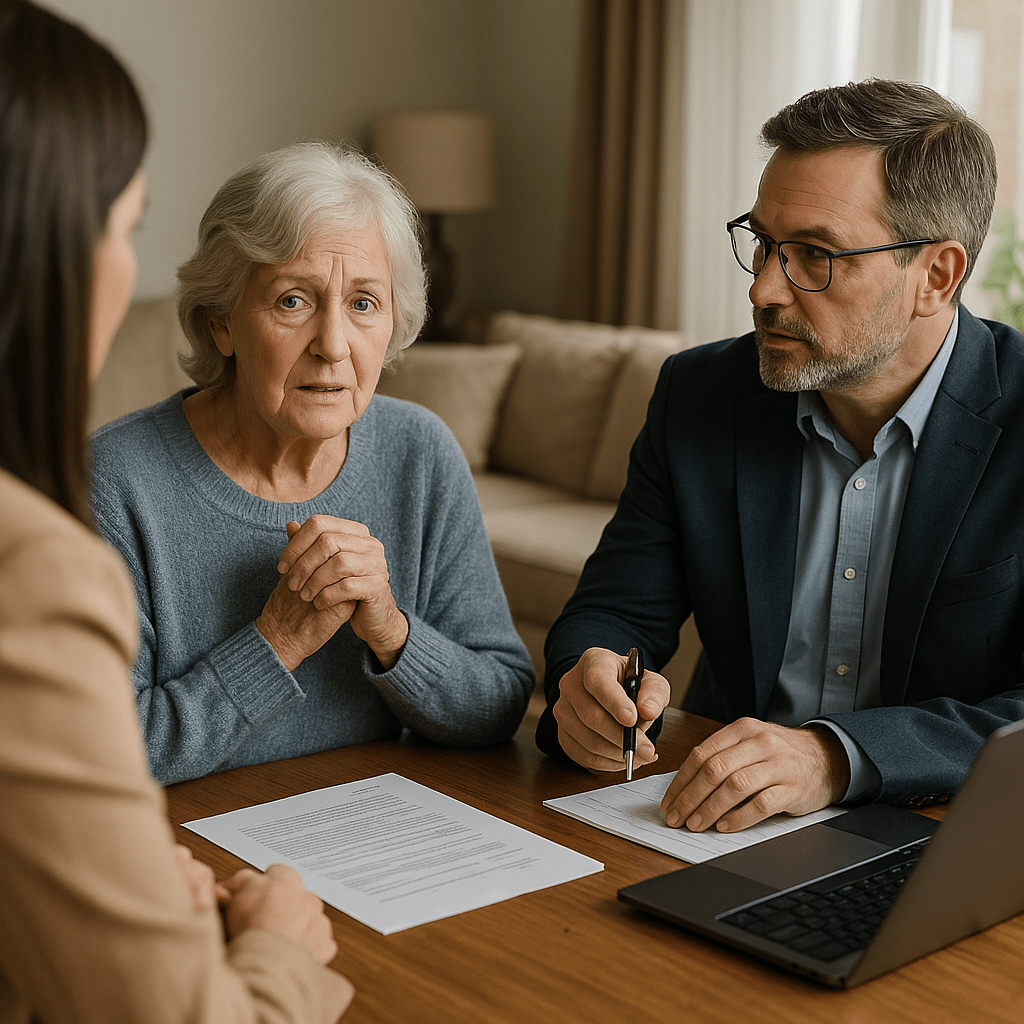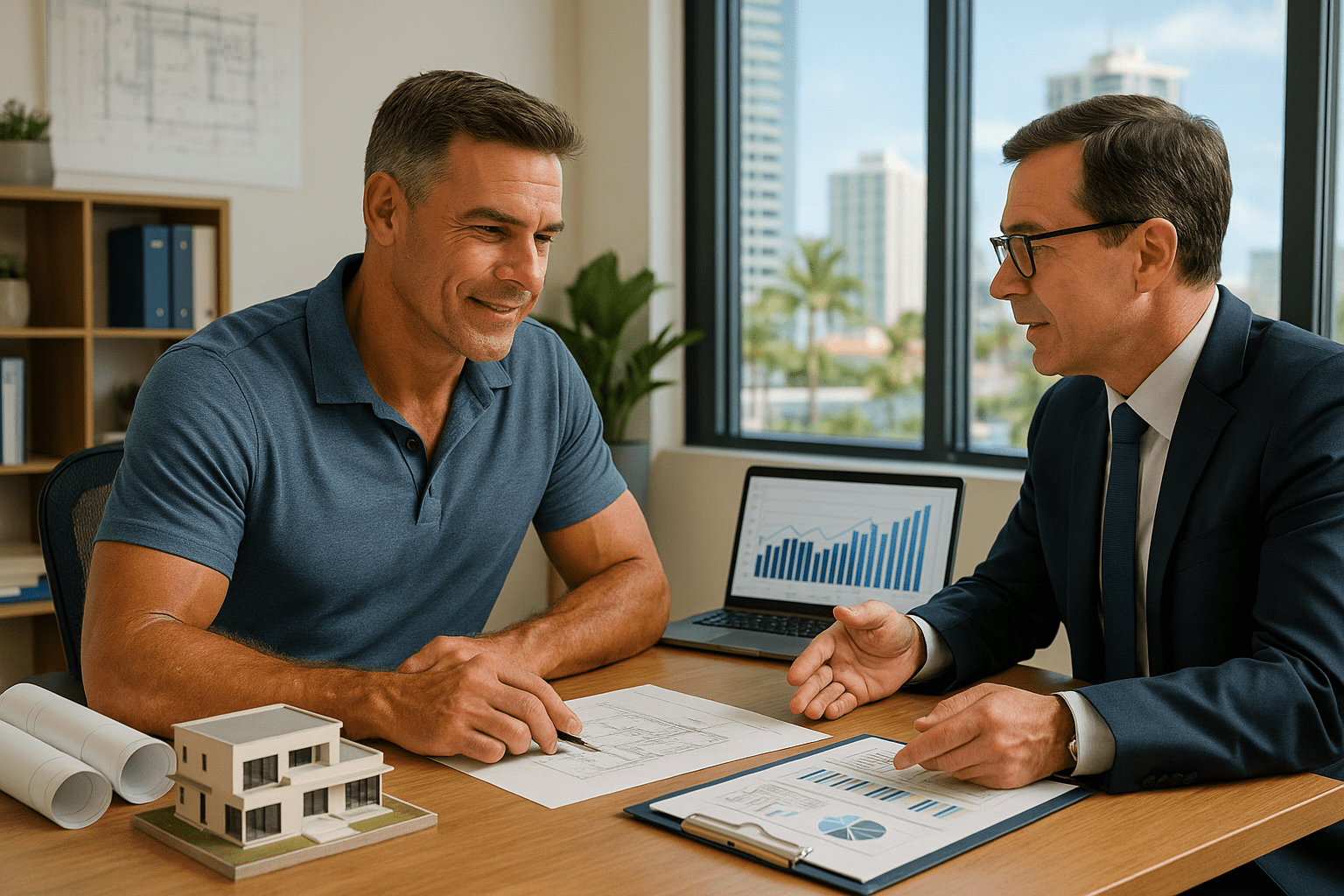
Reverse Mortgage Cash Out Refinance: Retired Nurse Accesses Equity for Healthcare and Family Support

Educational Case Study Disclosure
This case study is hypothetical and for educational purposes only. Scenarios, borrower profiles, loan terms, interest rates, and outcomes are illustrative examples and do not represent current offers or guaranteed terms.
For specific details including down payment requirements, closing cost estimates, interest rate details, closing cost breakdowns, payment calculations, cash-to-close estimates, or an official Loan Estimate, it is highly recommended you schedule a meeting with one of our licensed mortgage advisors.
Learn more:
- Reverse mortgage cash-out refinance Reg Z advertising requirements (§1026.24) – CFPB official regulation
- Reverse mortgage cash-out refinance Reg Z full text and compliance – Electronic Code of Federal Regulations
- Official reverse mortgage cash-out refinance advertising interpretations (§1026.24) – CFPB interpretations
- Reverse mortgage cash-out refinance MAP Rule (Reg N) mortgage advertising – Mortgage advertising rules
- NMLS Consumer Access – Verify reverse mortgage cash-out refinance lender licensure
Actual loan terms vary by credit profile, property, occupancy, location, market conditions, and lender guidelines. For current options tailored to you, schedule a consultation or apply online.
Ready to explore your options? Schedule a call with a loan advisor.
See How a Reverse Mortgage Cash-Out Refinance Provided Financial Flexibility While Eliminating Monthly Payments
Patricia M., a 71-year-old retired registered nurse in Phoenix, had lived in her home for twenty-eight years and owned it free and clear after paying off her mortgage five years earlier. She’d worked hard throughout her nursing career, saved diligently, and entered retirement with the peace of mind that comes from owning a home outright. But now she faced unexpected financial pressures that threatened her retirement security: increasing healthcare costs for a chronic condition requiring ongoing treatment, the need to help her daughter recover from a difficult divorce, and her grandson’s college expenses that she wanted to support. Her retirement income from her nursing pension and Social Security covered basic living expenses comfortably, but she didn’t have substantial liquid savings to handle these significant family and healthcare needs.
Patricia had built substantial equity in her Phoenix home through decades of appreciation. The property was worth significantly more than when she’d purchased it, representing her largest financial asset. But that equity sat locked in her home while she struggled to find ways to support her family and manage healthcare costs without depleting the modest savings she’d earmarked for long-term care needs. This wasn’t just about accessing money—this was about being able to support her family during critical moments, maintain her health through proper medical care, and preserve her independence and dignity throughout retirement while still leaving something meaningful for her children and grandchildren.
Facing similar challenges? Schedule a call to explore your options.
The Challenge: How Could Patricia Access Home Equity Without Creating Monthly Payment Obligations?
Patricia explored several options for accessing her substantial home equity. She considered traditional cash-out refinancing, home equity loans, and HELOCs. While all these options could provide the capital she needed, they all shared one major problem: they required monthly payments that would strain her fixed retirement income.
Why Couldn’t Patricia Take on Monthly Payment Obligations?
Patricia’s retirement income was predictable and stable—her nursing pension provided modest monthly income, Social Security added reliable support, and small investment distributions supplemented these sources. However, her income was also fixed and limited. The healthcare costs for her chronic condition were ongoing and substantial, consuming a significant portion of her monthly budget already.
“I spoke with lenders about traditional equity access options, and they all required monthly payments I simply couldn’t afford,” Patricia explained. “A home equity loan or HELOC would give me the cash I needed, but the monthly payments would force me to cut back on necessary healthcare spending or daily living expenses. I’d spent five years enjoying the freedom of no mortgage payment—taking on monthly obligations now would eliminate that financial peace and stress I’d worked so hard to achieve.”
How Do Traditional Equity Access Products Work Against Fixed Retirement Income?
Traditional equity access products—cash-out refinances, home equity loans, and HELOCs—all require regular monthly payments of principal and interest. For retirees on fixed incomes, these payment obligations can be particularly problematic because retirement income doesn’t increase to accommodate new debt service. Patricia’s income was sufficient for her planned retirement lifestyle, but it couldn’t comfortably absorb additional monthly payment obligations.
What Family Support and Healthcare Needs Was Patricia Unable to Meet?
The financial pressures Patricia faced were real and urgent. Her daughter’s divorce had left her financially vulnerable and needing help with temporary living expenses while she got back on her feet. Patricia’s grandson had earned admission to an excellent university but faced substantial costs even after financial aid. And Patricia’s own healthcare situation required ongoing treatment and medications that were expensive even with Medicare coverage.
Without access to her home equity, Patricia faced heartbreaking choices: tell her daughter she couldn’t help during a crisis, watch her grandson pass up educational opportunities due to finances, or skip necessary healthcare treatments to free up cash for family support. None of these options aligned with her values or her vision for how she wanted to use the wealth she’d accumulated through decades of hard work and responsible homeownership.
Experiencing similar challenges? Schedule a call to discuss alternative qualification methods.
The Discovery: Learning About Reverse Mortgage Cash-Out Refinance Programs
How Did Patricia Discover Reverse Mortgage Cash-Out Refinance Solutions?
Patricia discovered reverse mortgage cash-out refinance programs during a conversation with a friend from her church who had recently used a reverse mortgage to access equity for home modifications and healthcare expenses. The friend explained that she’d been able to access substantial equity from her home without taking on monthly mortgage payments, giving her the financial flexibility she needed in retirement.
Intrigued by this possibility, Patricia researched reverse mortgages thoroughly, attended a free educational seminar on reverse mortgage options, and scheduled a consultation with a reverse mortgage specialist. She brought documentation of her home’s value, her healthcare cost projections, and detailed information about the family support she wanted to provide.
What Makes Reverse Mortgage Cash-Out Refinance Different from Traditional Equity Access?
During the consultation, the reverse mortgage specialist explained how reverse mortgage cash-out refinance—technically called a Home Equity Conversion Mortgage (HECM)—works fundamentally differently from traditional equity access products. Instead of creating monthly payment obligations, a reverse mortgage allows homeowners age 62 and older to convert home equity into accessible cash while eliminating required monthly mortgage payments.
The specialist walked Patricia through the structure: because she owned her home free and clear, the entire reverse mortgage amount would be available to her as cash proceeds. She could choose to receive this as a lump sum for immediate needs, a line of credit for ongoing flexibility, or a combination of both. She would never be required to make monthly principal and interest payments as long as she lived in the home as her primary residence, paid property taxes and insurance, and maintained the property.
The loan balance would gradually increase as interest accrued over time, but Patricia would never owe more than the home’s value when the loan eventually came due. Her heirs could choose to repay the balance and keep the home, or sell it to satisfy the loan and keep any remaining equity.
“That consultation gave me hope for the first time in months,” Patricia said. “I could access the equity I’d built over nearly thirty years, help my family during critical moments, ensure I received proper healthcare, and maintain my financial independence—all without taking on monthly payments I couldn’t afford. This wasn’t just about getting cash; it was about using my home’s value strategically to support my family and protect my health while preserving my dignity and independence throughout retirement.”
The Solution: Reverse Mortgage Cash-Out Refinance Approval and Fund Access
What Documentation Did Patricia Provide for Reverse Mortgage Cash-Out Refinance Approval?
Patricia worked with her reverse mortgage specialist to complete the required documentation and mandatory counseling for a reverse mortgage application. The process emphasized consumer education to ensure she fully understood the product.
Documentation and requirements:
- Proof of age (Patricia was 71, well above the minimum age requirement)
- Completion of HUD-approved reverse mortgage counseling session
- Financial assessment demonstrating ability to pay property taxes and insurance
- Retirement income documentation (pension statements, Social Security award letter)
- Bank statements showing current financial position
- Property deed confirming ownership
- Property appraisal of her Phoenix home
- Homeowners insurance documentation
- Property tax payment history
- Documentation that the home was her primary residence
- Credit report review for financial assessment purposes
- Outstanding debt verification (none, as home was owned free and clear)
How Does the Reverse Mortgage Cash-Out Refinance Process Work?
The approval and funding process:
- Initial consultation – Discussed reverse mortgage structure and cash-out options
- Needs assessment – Evaluated Patricia’s financial goals and fund usage plans
- Mandatory counseling – Completed HUD-approved reverse mortgage education
- Financial assessment – Verified ability to meet ongoing property obligations
- Property appraisal ordered – Independent valuation of Phoenix home
- Appraisal completed – Substantial home value confirmed
- Loan amount calculation – Determined available proceeds based on age and property value
- Application submission – Filed complete reverse mortgage application
- Disbursement election – Patricia chose combination of lump sum and line of credit
- Underwriting review – Complete evaluation of eligibility and property
- Loan approval – Approved for reverse mortgage cash-out refinance
- Closing scheduled – Coordinated closing at Patricia’s convenience
- Closing completed – Reverse mortgage funded with no monthly payment obligation
- Funds disbursed – Lump sum distributed and line of credit established
The reverse mortgage lender structured Patricia’s cash-out refinance based on several factors: her age (older borrowers can access higher percentages of home value), the appraised value of her Phoenix property, and current reverse mortgage program limits. Because Patricia owned her home free and clear, she had no existing mortgage to pay off, so the entire available loan amount could be distributed to her as accessible funds. She chose to take a substantial portion as an immediate lump sum for her daughter’s needs and her grandson’s education, while establishing a line of credit for healthcare expenses and future needs.
Exploring refinance? Submit a refinance inquiry to compare your options.
The Results: Patricia Supports Family and Maintains Healthcare While Eliminating Payment Stress
What Results Did Patricia Achieve with Reverse Mortgage Cash-Out Refinance?
Patricia completed her reverse mortgage cash-out refinance approximately ten weeks after her initial consultation. The process provided her with immediate access to substantial funds plus a flexible line of credit for future needs, all while eliminating any required monthly mortgage payments.
Final outcome:
- Accessed substantial equity from mortgage-free home
- Received immediate lump sum for urgent family and education needs
- Established line of credit for ongoing healthcare and future flexibility
- No required monthly mortgage payments (only property taxes and insurance)
- Timeline: Consultation to closing in approximately ten weeks
- Property: 3BR/2BA single-family home, Phoenix, AZ
- Maintained ownership and right to live in home for life
- Preserved financial independence and dignity
- Peace of mind regarding family support and healthcare access
How Did Reverse Mortgage Cash-Out Refinance Compare to Traditional Equity Access Options?
Traditional cash-out refinance or home equity loan:
- Required monthly principal and interest payments
- Monthly payments would strain fixed retirement income
- Risk of foreclosure if payments couldn’t be maintained
- Patricia’s goals: BLOCKED ✗
Reverse mortgage cash-out refinance:
- No required monthly mortgage payments
- Fixed retirement income preserved for living expenses
- Financial flexibility achieved without payment stress
- Patricia’s goals: ACHIEVED ✓
What Family Support and Healthcare Security Did Patricia Achieve?
“Without the reverse mortgage cash-out refinance program, I would have had to choose between helping my family and maintaining my own financial security—I couldn’t have done both,” Patricia explained. “Now I’ve been able to support my daughter during her most difficult time, invest in my grandson’s education and future, ensure I receive the healthcare I need without cutting corners, and maintain the independence and dignity that matter so much to me in retirement. This decision gave me the ability to be the grandmother and mother I want to be while taking care of myself properly.”
Financial and family transformation results:
- Provided substantial financial support to daughter during divorce recovery
- Fully funded grandson’s first two years of university expenses
- Maintained comprehensive healthcare coverage and treatment plan
- No monthly mortgage payment stress on fixed income
- Preserved emergency reserves for long-term care if needed
- Line of credit continues growing for future healthcare or family needs
- Strengthened family relationships through ability to provide support
- Maintained independence and control over home and finances
- Grandchildren visiting regularly in the home they’ve always known
Patricia views this reverse mortgage cash-out refinance as one of the most empowering financial decisions of her retirement. She was able to convert home equity—wealth that was previously inaccessible—into practical financial support exactly when her family needed it most. Her daughter has successfully rebuilt her life and is now financially stable. Her grandson is thriving at university and deeply grateful for his grandmother’s support. And Patricia herself is receiving excellent healthcare without financial stress.
Her children initially had concerns about reverse mortgages, but after Patricia completed the mandatory counseling and shared the educational materials with them, they fully understood and supported her decision. They recognized that their mother’s quality of life, her ability to help family during crises, and her healthcare security were far more important than maximizing inheritance. They also appreciated that the reverse mortgage allowed Patricia to use her home equity strategically during her lifetime rather than letting it sit inaccessible while she struggled financially.
Looking ahead, Patricia knows she has additional financial flexibility through the line of credit if unexpected needs arise. The unused portion of her line of credit continues growing over time, providing an expanding financial safety net for healthcare expenses, home modifications if needed as she ages, or other future needs. She’s living in the home she’s loved for nearly thirty years, supporting her family meaningfully, maintaining her health, and preserving her independence—exactly the retirement security and family legacy she’d hoped to achieve.
Ready to get started? Get approved or schedule a call to discuss your situation.
Exploring Other Reverse Mortgage Options?
While Patricia used a reverse mortgage to access equity for family support and healthcare, reverse mortgage financing works for multiple scenarios:
- Ready to purchase? See how a retired teacher used reverse mortgage purchase for retirement home
- Need monthly income? See how a retiree used reverse mortgage income for cash flow
- Want payment elimination only? See how a homeowner used reverse mortgage refinance to eliminate monthly payments
- View all case studies to find success stories matching your situation
Key Takeaways for Senior Homeowners Considering Equity Access
- Reverse mortgage cash-out refinance eliminates monthly payment obligations—allowing seniors to access substantial home equity without creating payment stress on fixed retirement income, making it ideal for those who own homes outright or have small remaining mortgages (HUD reverse mortgage program details)
- Multiple disbursement options provide flexibility—borrowers can choose lump sum, line of credit, monthly payments, or combinations, allowing customization based on specific needs and goals
- Line of credit growth feature provides expanding safety net—unused reverse mortgage line of credit balances grow over time, creating an expanding financial resource for future needs (Consumer Financial Protection Bureau reverse mortgage guide)
- Non-recourse protection ensures heirs never owe more than home value—federal insurance protects borrowers and heirs, ensuring loan balance can never exceed property value even if interest accumulation and home value changes create imbalance
- Think strategically about equity timing—successful retirees recognize that home equity is wealth, and reverse mortgages allow them to access that wealth during their lifetime when they need it most, supporting family during critical moments, maintaining quality healthcare, and preserving independence while still building legacy through both financial and experiential gifts to future generations
Have questions about accessing your home equity? Schedule a call with a loan advisor today.
Alternative Loan Programs for Senior Equity Access
If a reverse mortgage cash-out refinance isn’t the perfect fit, consider these alternatives:
- Reverse Mortgage Purchase – Buy retirement home without monthly payments
- Reverse Mortgage Income – Generate monthly cash flow from equity
- Reverse Mortgage Refinance – Eliminate existing mortgage payments
- Home Equity Loan – Traditional equity access with monthly payments
- HELOC – Revolving credit line with monthly payments
Explore all loan programs to find your best option.
Helpful Reverse Mortgage Cash-Out Refinance Resources
Learn more about this loan program:
- Complete Reverse Mortgage Guide – Detailed requirements, benefits, and qualification guidelines
- Reverse Mortgage Calculator – Estimate your available equity access
Similar success stories:
- How a retired teacher used reverse mortgage purchase for retirement home – Purchase without payments
- Retiree generated monthly income with reverse mortgage income program – Income generation
- View all case studies – Browse by your journey stage
External authoritative resources:
- HUD reverse mortgage program details – Official government program information
- Consumer Financial Protection Bureau reverse mortgage guide – Independent consumer education
Ready to get started?
- Apply online – Start your application today
- Schedule a consultation – Discuss your equity access needs
- Submit reverse mortgage inquiry – Get personalized guidance
Need local expertise? Get introduced to trusted partners including loan officers, financial advisors, and elder care specialists in your area.
Need a Pre-Approval Letter—Fast?
Buying a home soon? Complete our short form and we’ll connect you with the best loan options for your target property and financial situation—fast.
- Only 2 minutes to complete
- Quick turnaround on pre-approval
- No credit score impact
Got a Few Questions First?
Not Sure About Your Next Step?
Skip the guesswork. Take our quick Discovery Quiz to uncover your top financial priorities, so we can guide you toward the wealth-building strategies that fit your life.
- Takes just 5 minutes
- Tailored results based on your answers
- No credit check required
Related Posts
Subscribe to our newsletter
Get the latest insights and mortgage case studies in your inbox.




